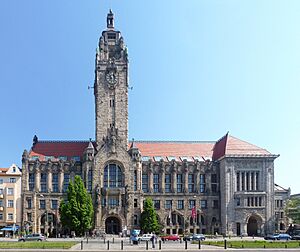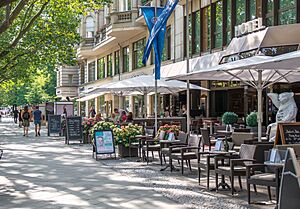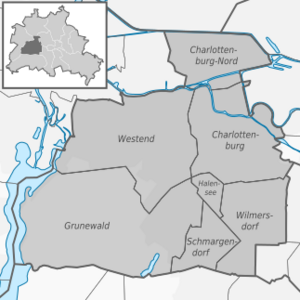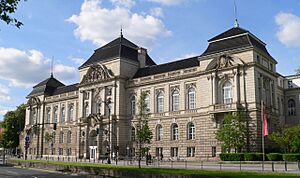Charlottenburg-Wilmersdorf facts for kids
Quick facts for kids
Charlottenburg-Wilmersdorf
|
|||
|---|---|---|---|
|
Borough of Berlin
|
|||

Charlottenburg Town Hall
|
|||
|
|||
| Country | Germany | ||
| State | Berlin | ||
| City | Berlin | ||
| Founded | 2001 | ||
| Population
(3431675)
|
|||
| • Total | 3,431,675 | ||
| Time zone | CET/CEST (UTC+1/+2) | ||
| Postal codes |
10585, 10587, 10589, 10623, 10625, 10627, 10629, 10707, 10709, 10711, 10713, 10715, 10717, 10719, 10777, 13627, 14050, 14052, 14053, 14055, 14057, 14059, 14193, 14197, 14199
|
||
| Dialling codes | 030 | ||
| Vehicle registration | B | ||
Charlottenburg-Wilmersdorf (German: [ʃaʁˌlɔtn̩bʊʁk ˈvɪlmɐsdɔʁf]) is the fourth borough of Berlin, formed in an administrative reform with effect from 1 January 2001, by merging the former boroughs of Charlottenburg and Wilmersdorf.
Contents
Overview
Charlottenburg-Wilmersdorf covers the western city centre of Berlin and the adjacent affluent suburbs. It borders on the Mitte borough in the east, on Tempelhof-Schöneberg in the southeast, Steglitz-Zehlendorf in the south, Spandau in the west and on Reinickendorf in the north. The district includes the inner city localities of Charlottenburg, Wilmersdorf and Halensee.
After World War II and the city's division by the Berlin Wall, the area around Kurfürstendamm and Bahnhof Zoo was the centre of former West Berlin, with the Kaiser Wilhelm Memorial Church as its landmark. The Technische Universität Berlin, the Berlin University of the Arts (Universität der Künste), the Federal Institute for Risk Assessment (Bundesinstitut für Risikobewertung), the Deutsche Oper Berlin as well as Charlottenburg Palace and the Olympic Stadium are also located in Charlottenburg-Wilmersdorf.
Demographics
As of 2012[update], the borough had a population of 326,354, of whom about 110,000 (34%) were of non-German origin. The largest ethnic minorities were Turks at 4%; Poles at 3.5%; Arabs, former Yugoslavians and Afro-Germans at 2.5% each; Russians at 1.5%; and Ukrainians and Iranians at 1.0% each.
| Percentage of the population with migration background | |
|---|---|
| Germans without migration background/Ethnic Germans | 66% (209,700) |
| Germans with migration background/Foreigners | 34 % (110,000) |
| – Middle Eastern/Muslim migration background (Turkey, Arab League, Iran etc.) | 8% (25,500) |
| – former Soviet background (Russia, Ukraine, Azerbaijan, Kazakhstan etc.) | 4.4% (14,000) |
| – Polish migration background | 3.5% (11,000) |
| – Yugoslavian migration background | 2.5% (7,500) |
| – Afro-German/African background | 2.5% (7,500) |
| – Others (Greeks, Italians, East Asians etc.) | 13.1% (44,500) |
Subdivision
Charlottenburg-Wilmersdorf is divided into seven localities:
| Locality |
Area (km2) |
Inhabitants 31 December 2012 |
Density (inhabitants/km2) |
| 0401 Charlottenburg |
10.6 | 121,926 | 11,502 |
| 0402 Wilmersdorf |
7.16 | 95,164 | 13,291 |
| 0403 Schmargendorf |
3.59 | 20,476 | 5,704 |
| 0404 Grunewald |
22.3 | 11,703 | 525 |
| 0405 Westend |
13.5 | 38,944 | 2,885 |
| 0406 Charlottenburg-Nord |
6.2 | 73,057 | 11,783 |
| 0407 Halensee |
1.27 | 12,759 | 10,046 |
The localities of Schmargendorf and Grunewald were part of the former Wilmersdorf borough until 2001. By resolution of 30 September 2004, the localities of Westend and Charlottenburg-Nord were created on the territory of the former Charlottenburg borough, like Halensee on the territory of the former Wilmersdorf borough.
Twin towns – sister cities
Charlottenburg-Wilmersdorf is twinned with:
 Apeldoorn, Netherlands (1968)
Apeldoorn, Netherlands (1968) Bad Iburg, Germany (1980)
Bad Iburg, Germany (1980) Belváros-Lipótváros (Budapest), Hungary (1998)
Belváros-Lipótváros (Budapest), Hungary (1998) Forchheim (district), Germany (1991)
Forchheim (district), Germany (1991) Gagny, France (1992)
Gagny, France (1992) Gladsaxe, Denmark (1968)
Gladsaxe, Denmark (1968) Karmiel, Israel (1985)
Karmiel, Israel (1985) Kulmbach (district), Germany (1991)
Kulmbach (district), Germany (1991) Lewisham, England, United Kingdom (1968)
Lewisham, England, United Kingdom (1968) Linz, Austria (1995)
Linz, Austria (1995) Mannheim, Germany (1962)
Mannheim, Germany (1962) Marburg-Biedenkopf, Germany (1991)
Marburg-Biedenkopf, Germany (1991) Międzyrzecz, Poland (1993)
Międzyrzecz, Poland (1993) Minden, Germany (1968)
Minden, Germany (1968) Or Yehuda, Israel (1966)
Or Yehuda, Israel (1966) Pechersk (Kyiv), Ukraine (1991)
Pechersk (Kyiv), Ukraine (1991) Rheingau-Taunus (district), Germany (1991)
Rheingau-Taunus (district), Germany (1991) Split, Croatia (1970)
Split, Croatia (1970) Sutton, England, United Kingdom (1968)
Sutton, England, United Kingdom (1968) Trento, Italy (1966)
Trento, Italy (1966) Waldeck-Frankenberg, Germany (1988)
Waldeck-Frankenberg, Germany (1988)
Economy

The borough's economy largely depends on retail trade, mainly in the City West area along Kurfürstendamm, Breitscheidplatz and Tauentzienstraße, with supra-local importance.
The Berliner Börse (Berlin Stock Exchange) is housed in the Ludwig-Erhard-Haus designed by Nicholas Grimshaw at Fasanenstraße 85 in Berlin-Charlottenburg near Bahnhof Zoologischer Garten
The Royal Porcelain Factory in Berlin (German: Königliche Porzellan-Manufaktur Berlin) (KPM) is also situated in Charlottenburg, near Berlin-Tiergarten Station
The Messe Berlin (Exhibition Grounds/Trade Fair Center) is situated in Berlin-Westend
Air Berlin had its headquarters in Building 2 of the Airport Bureau Center in Charlottenburg-Nord. As of 2006[update] Air Berlin employed 1,200 employees at its headquarters. Germania has its headquarters in Charlottenburg-Nord.
Education
There are 74 schools in the city. There are 29,446 students attending these schools, 5,261 are foreigners. Of the 12,993 students studies in 38 primary schools while the number of students studying in the ymansiums is 9,617. In addition, there are 3 Hauptschule, 6 Realschule and 14 Gymnasium in the Charlottenburg-Wilmersdorf.
The district also has two universities, Technische Universität Berlinn and Berlin University of the Arts. In 2011, Technische Universität Berlin was named the 46th best university in the world in engineering and technology according to the QS World University Rankings.
Higher education
- Universität der Künste (Berlin University of the Arts)
- Technische Universität Berlin
- Bbw University of Applied Sciences
- ESCP Business School
- Touro College Berlin
Primary and secondary schools
- Comenius-Schule, a primary school, is in Wilmersdorf.
- Halensee-Grundschule, a primary school, is in Halensee.
- Jüdische Traditionsschule, traditionell Jewish primary and secondary school in Westend
- Heinz-Galinski-Schule Charlottenburg, Jewish primary school
- Svenska Skolan Berlin, Swedish School Berlin
- Nelson-Mandela-School, International School
- Goethe-Gymnasium, one of the most popular secondary schools in Berlin
- Peter-Ustinov-Schule, located between Messe Nord and Wilmersdorfer Straße.
- Evangelisches Gymnasium zum Grauen Kloster, School of the Evangelical Church
Weekend education
- The Japanische Ergänzungsschule in Berlin e.V. (ベルリン日本語補習授業校 Berurin Nihongo Hoshū Jugyō Kō), a weekend Japanese supplementary school, is held at Halensee-Grundschule.
- Zentrale Schule für Japanisch Berlin e.V. (共益法人ベルリン中央学園補習授業校 Kyōeki Hōjin Berurin Chūō Gakuen Hoshū Jugyō Kō), another weekend Japanese supplementary school, is held at the Comenius-Schule – Established April 1997.
See also
 In Spanish: Charlottenburg-Wilmersdorf para niños
In Spanish: Charlottenburg-Wilmersdorf para niños





